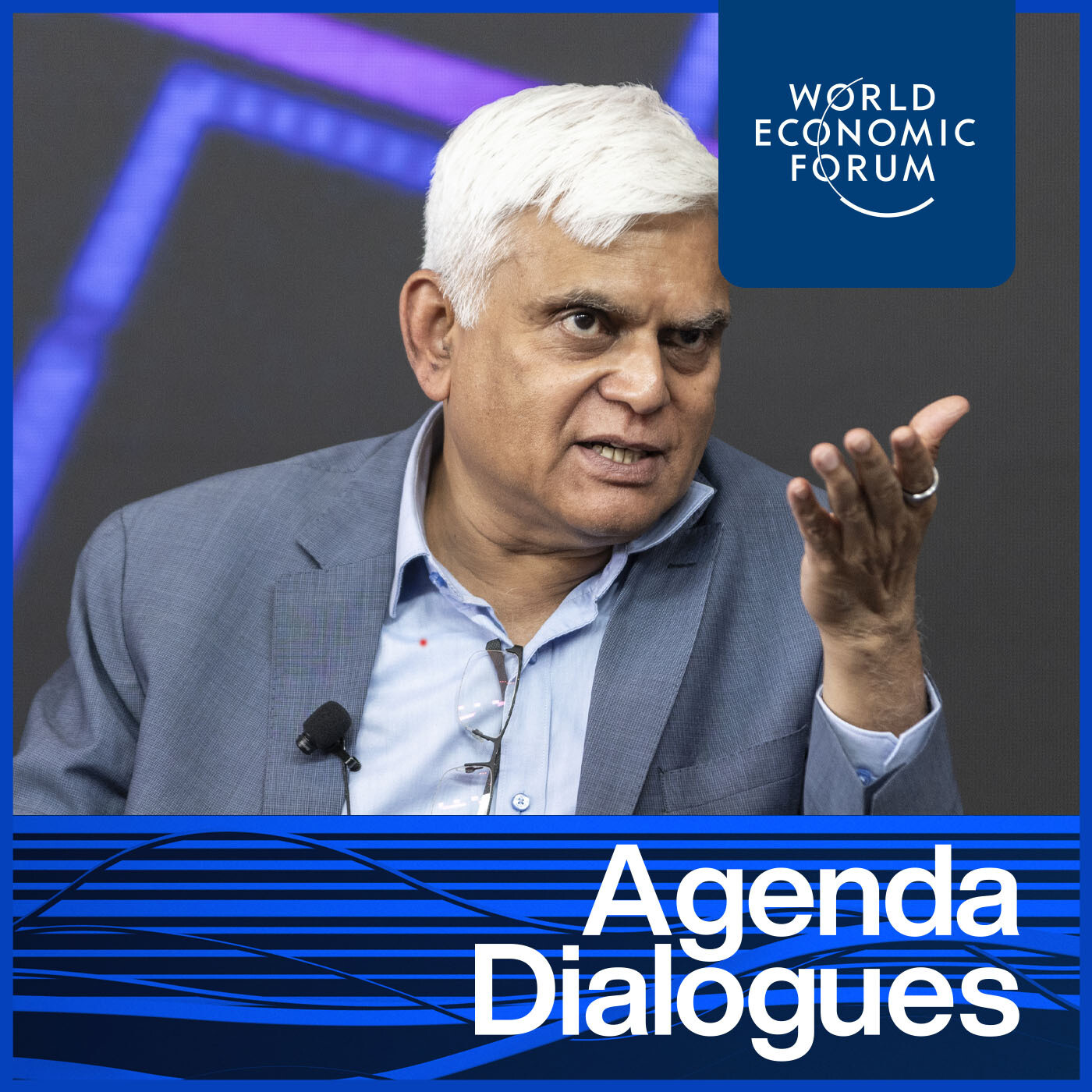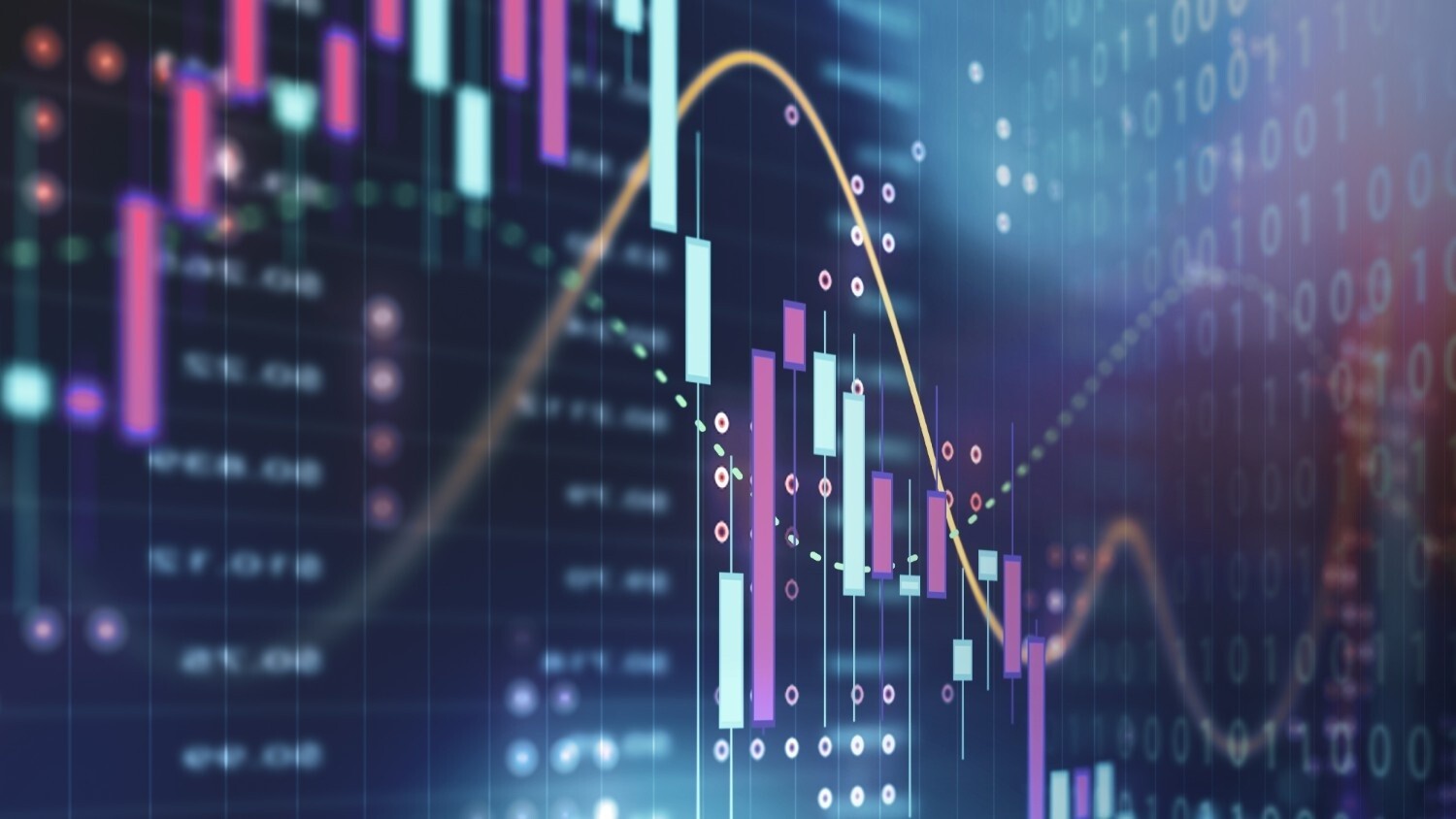Chief Economists Outlook May 2025
播客文字稿
This transcript has been generated using speech recognition software and may contain errors. Please check its accuracy against the audio.
Saadia Zahidi: What's the outlook for the global economy? How can we navigate this era of uncertainty? And what might a new economic future look like? We've asked economists from the world of business and beyond for their views on these questions for our Chief Economist Outlook. I'm Saadia Zahidi and this is the briefing room from the World Economic Forum. I'm joined by three guests who will bring us different perspectives on the new numbers. We have three chief economists joining us today. Sandra Philippen of ABN Amro, Guy Miller of Zurich Insurance here in Geneva with me, and Jinny Yan of ICBC Standard joining us from London. Welcome everyone.
Saadia Zahidi: We've seen seismic shifts and shocks in US trade policy in recent months. It looked to some or for some time that we were on the brink of a global trade war. We've asked economists about the impact of US government policies on the trajectory of the global economy. Would it be a real long-term shift or are we talking about a short-term disruption here? Their answers collected through a survey in mid-April were stark. 79% of those questioned said that this was a long-term shift, and just 21% thought that this would be a short-term change. Since then, we've seen things to some extent come down with a de-escalation in the US-China trade relationship, but uncertainty most definitely remains. And so perhaps I can start with two guests in the studio with me first. Do you think this is a short-term shift or a long-term disruption?
Sandra Philippen: I think it's a long-term disruption and I think, yeah, the word uncertainty is an interesting word because, you know, we've come to learn about new layers in uncertainty, right? So economists often deal with uncertainty, even each forecast contains a lot of uncertainty. And then we have uncertainty in the economic fundamentals. And I think what we're now seeing is potentially even uncertainty in the... Yeah, what I call super fundamentals, right? So there, we haven't had, I mean, I haven't an experience with thinking about uncertainty, about the legal system, about democracy, about, yeah, so many fundamental things.
Saadia Zahidi: Guy, your perspective, in particular on the point on trade.
Guy Miller: Yeah, so look, I think it's very easy when you see profound change to extrapolate that. And quite often, it's never quite the way you might think it is. I think this is significant, however, but it's the context that's important. Remember, this comes on the back of a global pandemic, where we had seen some of the flaws in supply chains, some of them very efficient companies, production technologies and methods. They were beginning to come into question. We realised that perhaps not all the risk. Our very tight supply chains were priced correctly. So we have begun to see a shift, I think, anyway to broaden out suppliers, to broaden our key inputs into production processes. What we're seeing with the new Trump administration is, again, on top of that. And I think there's a realisation from companies' perspective and other governments that there perhaps was too many dependencies on one or two key partners. So I think that there is move to broaden that out that will be long lasting. But I'm not sure that it's going to be quite as profound over the coming decades that some of the survey's results might suggest in the near term.
Saadia Zahidi: Okay. And Jinny.
Jinny Yan: Your perspective on this. So I think it's very important to distinguish between the short term economic cycle or business cycle and also the longer term shift in terms of the new global economic order. So, I think the uncertainty, particularly in recent weeks, has really shown us that what we traditionally see as the high risk economies potentially is no longer where the shocks are coming from. Actually the more developed markets and obviously these sizable shifts in both short-term business cycles as well as longer-term trends and the interaction of those is what's really concerning a lot of investors and corporates because business decisions absolutely depend on stability of your views on some of these markets. So for me the interaction between business cycles and the longer term shift in global economic order. And of course, the supportive instruments to try and mitigate those risks, navigate the markets will be incredibly important.
Sandra Philippen: Sandra? Yeah, I think it's interesting because indeed there is the structural and the cyclical and I think but whether or not it is temporary and also you refer back to the pandemic. I think kind of for me a really fundamental difference as well is that a pandemic basically happened to us right? It's an exogenous shock. And here it's something that a government is proactively doing upon primarily itself and then also the rest of the world. So that's different. And it's in many ways different because you could also imagine that at some point there would be a massive U-turn and it all evaporates, right? So.
Guy Miller: And I think that's the key point is that it's a lack of clarity that we have currently. It's the erratic nature, the start-stop nature. If you're a company, should I invest today? Should I wait to tomorrow? Do I wait for more clarity? And you see that from a consumer's perspective as well. So whether it's business investment or whether it is consumption, I think right now there's a let's wait and see. And of course that wait and see means that growth will be impacted ultimately as a result.
Sandra Philippen: Yeah, that's true. And maybe also, I think what's interesting to that, so we speak to a lot of clients, of course, corporate clients, and they're also, the argument sometimes being made, and I'm kind of curious how the answers from the US would be different than the answers form Europe, but if you assume that the intention of all of this is make American manufacturing great again, then of course you have to provide corporate incentives to to relocate into the US and then make investments very attractive, right? You have to incentivize that and we see the opposite happening. So even a tariff, if it's very high, it might lead to some clients of us, maybe even to relocates their manufacturing to the US, which is what the White House wants. But then if you reverse those tariffs, then basically you create, again, a competitive disadvantage for the firms that we're considering to actually do that. So that is the fundamental uncertainty. That is just keep everybody sitting where they're sitting.
Saadia Zahidi: Responses that we got assumed that there would be a reaction or countermeasures from other countries and that all of this together will have a negative impact, not just on the countries that it's intended to have a positive impact on, but also on the U.S. And potentially for a fairly large share, there was also concern that this is going to have big systemic impact on the global economy. So where do you come in on that?
Jinny Yan: I was just going to also add on from what Sandra and Guy mentioned about the business cycle versus structural shift. My argument is that the compounded effect, that actually the world hasn't fully recovered from COVID impacts, certainly in China what we saw was that obviously there's a lot of concerns about China's growth and China's current growth model, whether the traditional growth drivers is sufficient. And obviously policy dynamics, a lot of the Western economies, for example, still reacting on the back of inflation fears. Different story in China in that a lot of the debt issues and other related to the lack of consumption, etc. So I think it's a compounded effect of those short term measures as well as a longer term shift because the seismic shocks are coming from everywhere, not just tariffs. I would argue that a lot of the uncertainty is coming both from structural. As well as the short-term policy decisions. So business decisions aren't just simple as what it used to be, looking at the key drivers and key things, but it's simultaneously look at the longer term. And by long term, we define long term usually five years, 10 years. But for example, in some regions we're looking much further beyond. You think of the Middle East, for example certainly in China and many others. So I think, obviously, policy reactions are important to read, but more importantly, the vision of strategic goals for investment decisions, particularly longer-term mega-infrastructure business decisions.
Saadia Zahidi: And Ginny, you raised the point of the picture being quite different in different regions, and we find in the latest survey that there's quite a bit of concern about low growth in the United States and in Europe. And with China, the picture is a little rosier, but at the same time, they were equally divided in terms of whether China will meet its 5% target or not. And then again, the pictures a little more dynamic in South Asia and the Middle East. What are you seeing in some of the data that you're all working on? Regarding China, you mean? China and other regions. Where do you see greater opportunity for growth and a more positive economic outlook?
Sandra Philippen: On the short term, I am... You might see, indeed, if trade routes start to realign, the disadvantage for one connection automatically generates comparative advantages for the other connections, right? That's the way it goes. So to give an example, if, and you know, some of it is being reversed, but let's just hypothetically, if the U.S. Would... Slap a 20% tariff on Europe and a 150% tarif on China, then basically China is taking the brunt here and Europe is going to relatively benefit from that because someone is going to jump into the gap of trade not being done in a certain route. So that is always the case. I think I would be very hesitant for now to say. Who's actually gonna benefit with all these dynamics kind of up in the air right now.
Guy Miller: Maybe just to pick up on that, because I think some of the latest data coming from Asia shows that, as you would expect from China as well, there's a way of rerouting goods. You find better ways of doing things to circumvent some of tariffs. That was almost inevitable. And you're seeing that's perhaps one of the reasons the US administration want to encourage other countries to put tariffs on China as Well, because you're seeing what you saw the first time around with tariffs is that you find different ways of doing that. But I think one thing is really important, while it's very easy to think of all the negatives that's going on here, to your point about where there's some winners, if you like, I still think it could be Europe and China, because frankly, the hand of Europe is now being We've all read and we all know that Europe need to reform and change. And what we're seeing as a result of the US administration, it is making Europe change. It is making your follow up and a lot of the proposals that have been put forward by the Draghi Report letter. And it needs to change. And now there is an incentive to do so. In the case of China, shifting the economy more towards perhaps a consumer-driven economy as well, still early days. But we cannot rely on one end consumer, the US. We need to find other ways of doing that. And that's quite healthy. It gives a better balance on the global stage. We need see if it really is followed through. But I suspect this is a catalyst to galvanise that desire to improve domestic or regional growth.
Saadia Zahidi: So let's stick with Europe for a second. So here, there's obviously expectations that there will be potentially looser fiscal policy, potentially more spending on defence. And at the same time, we see in the data for the first time as high of a concern about debt in advanced economies as in developing economies. So how do we square that circle? How do you think policymakers are going to do some of the spending that's needed for grasping the current opportunity?
Guy Miller: Well, we've seen an example in Germany. Who would have thought, six months ago, that Germany would be spending one trillion euros over the course of 10 years, easing the debt break, and actually spending on things that needs to improve not only the robustness of the German economy, but the efficiency. And that's an example for the rest of Europe, I think, to follow through. Now, other countries are more constrained in terms of their ability to raise debt and debt to GDP is a problem. But it shows you if you can focus on productivity improvements, raising growth, then you can manage that. And I think there is now a desire to do that. We need mutualization or more mutualization of debt in Europe to encourage that to come through. But I suspect we're going to see that. So there is some light there. But we need to make sure that a lot of these proposals are followed through on we don't back off in the months ahead.
Sandra Philippen: Yeah, well, I agree on on the opportunities in the long run, but I do think in the short run, Europe's in for quite some pain, right? So I so maybe to distinguish both of these elements a little bit and a tariff directly hurts from the U.S. Hurts, hurts exporters, hurts growth in Europe and growth is an all in all disinflationary. That might help when interest rates go down a bit. That is actually interesting for the decarbonisation and renewable energies that Europe is kind of setting still full pace on. And because those technologies become a lot cheaper relative to the fossil technologies, but there's so much else going on that's also impactful and can't be ignored. So just to give an example. If indeed the China-US route is being distorted, there will be overcapacity from China that needs to go somewhere. That wants to go to Europe is going to hurt certain sectors in the European economy. It's going to help other sectors that you actually never hear about because it's actually to help other sectors decarbonize against much lower costs at the same time. And then if the whole global trade system gets distorted, that means less transport, less demand for energy, lower energy prices, again, disinflationary. So those things are, in the short term, I would say for Europe, really a negative. On the other hand, there is the defence spending in Europe, there is a German infrastructure bill. There is a kind of, I just came from two days in Brussels with the annual budget conference. It's starting to negotiate about the new financial framework. And it's very interesting because I've been watching Europe for a long time already. I've never seen them so confident and so willing to step up the game and try to indeed shift those structural forces into a relative advantage for Europe. It's interesting.
Jinny Yan: Ginny, your view? I would agree with Guy in that those economy who will benefit on the back of the current economic situation are those with plenty of fiscal room. And obviously Germany already mentioned China is another one, this year 1.3 trillion of that fiscal stimulus and potentially more. And of course these industrialising nations obviously will not only produce for their own domestic economies and obviously we know that wheat consumption is still very much a theme in those domestic economies, but actually production for global capacity. So I would say that I think those who are able to and those who don't have maybe a huge issue with debt sustainability, for the moment at least, will likely to benefit and weather the headwind when it comes to trade and tariff impacts. On Sandra's point about overcapacity in China, I would mention I think in the short term, certainly, it is unlikely that we're going to see flooding of China's particularly things like electric vehicles and other products that clearly China has become more competitive, have gained competitive advantage over into Europe because there's plenty of trade barriers already there. What I do see, however, is lots of industrialising nations, particularly emerging markets. That will welcome these higher-end manufactured products. But the partnership between China and Europe, I particularly am quite encouraged by, because this is something that has already been ongoing, but for the partnership to produce together for the benefit of it maybe exporting to other nations. So really it's about innovation and know-how, high quality, production of high quality goods in order to supply to the restful world. So I obviously think that the point about deflation is very much prevalent, especially in China, because we are still seeing the impact of disinflation. But I think the overcapacity issue may be a little bit differentiated, depending on the region. I would say that in a nutshell for me, diversification, domestic capacity, and also de-risking for me are the three Ds that really... Exemplify and also demonstrate how nations are going to be able to become more resilient to short-term shocks from tariff wars.
Sandra Philippen: Pinky, may I ask you a question on that? So I'm actually quite curious how you see the trade barriers being enacted in practise. So there's a little bit of a worry in Europe that the Chinese overcapacity is going to be actually bigger than the trade barrier can stop or disincentivize because there are ways to circumvent those barriers and I think they're being fully exploited. How do you see that?
Jinny Yan: There's been an ongoing issue. And in the past few years, we have seen more and more Chinese corporates wanting to access the EU market in particular, but clearly, the automakers so clearly the rise of China's automakers, you know, that have become much more competitive in the sector supplying to the rest of the world. And now what we see, particularly talking to a lot of the Chinese corporats is actually, they are seeking partnerships not only to supply EU. So I think that the recent negotiations very much is about not just looking at the end product of these autos or things that traditionally Europe has had the advantage over, but actually to partner in the entirety of the supply chain. To give you an example, batteries or goods and items that related those batteries and obviously commodities from elsewhere, the raw materials on those So clearly, when we come to think about the barriers to entry, there is pre-existing barriers already. And we know that because it's been very challenging for a lot of Chinese brands to enter those markets. So I think then to navigate that, Chinese corporates have already become quite good at seeking partnerships, and also to look across the supply chain to make sure that there is. You know, the cake is big enough for everyone, there's plenty of room for growth for all partners.
Saadia Zahidi: So we talked a bit about the US, we've talked about Europe, we've talk about China, but the key word through all of this is uncertainty. And this is certainly a time of unprecedented uncertainty with swings, U-turns, reversals, keeping everyone, especially those of us who watch the global economy for a living on our toes. Our latest chief economist outlook found that 82% of those surveyed think that uncertainty is very high. And just 56% think that it's going to be any lower a year from now. So with, and with tariffs, the key focus, that's the area, trade policy, which economists see as most uncertain. So monetary policy comes in second place with 49% saying they see that uncertainty and then fiscal policy slightly lower at 35%. So uncertainty across various areas of policy. And then of course, a huge risk of potential policy miscoordination. So how are businesses expected to react? How are they currently reacting? Who's doing this well? What are the big bets that they can still make? What are they no regret moves? Just a bit of a view from each of you on that and whoever would like to go first.
Guy Miller: Maybe starting off, I think one should remember the survey was done at kind of peak uncertainty. It was a very difficult environment. And I think over time, the uncertainty will come down because you begin to know the players, you begin to know that the constraints on those players, particularly the US administration. We've already seen some of that in terms of the shift and stance on tariffs. That's been a function clearly of the financial markets and what was going on with bonds. One shouldn't get the markets matter to politicians as well. We've also seen it in terms of corporate America, in terms of the CEOs, they're giving feedback to the politicians about how their business is going, the fact that they're not able to invest the way they otherwise would. So I think over time, once you get to understand the players a bit more, I think some of that uncertainty goes, but I would say that the environment that we're in today compared to a year or so ago is very different. And from a company perspective, that really matches because if you're going to commit to plant an equipment that takes three, five years to build, You need to have an idea of what that playing field is going to be like. I mean, we touched on that a little bit earlier. But this means that companies who are dynamic, who have the ability to take advantage of dislocations, who are able to commit capital for the longer term areas that they feel they need to be in, I think will still prosper. Ultimately, while the politicians shape the backdrop, companies will still focus on the profit motive. And they will put investments where they see it being best. They'll move money and they'll A capacity where it should be in order to do that.
Saadia Zahidi: Are they doing that or do you feel decision-making is very much in the way?
Guy Miller: I think it's in hold now. I think is absolutely in hold. For the reasons mentioned, I think Sandra touched on this earlier, if you don't know what the landscape is going to be in a few months time, if policy could completely reverse, you're in trouble. We saw that with the relationship between America and Canada in the past. Companies who maybe set up business in Canada a few years ago, suddenly they're finding that they're going to be penalised. So companies need clarity to invest for future growth. And that's where I think when we speak about tariffs, it's not so much the tariffs themselves, because I think structural change, individuals, companies, governments can adapt to. What I think is very hard to adapt to is that uncertainty. And that is the thing that we need to resolve. And I think the US administration will also see it's in their own interest to resolve that so that companies can potentially invest in America and so that global growth begins to recover and jobs are created globally, including in America.
Sandra Philippen: Thought of a metaphor when you were explaining this. I think if you look at it from a global macro perspective, global trade system is like an ant's heap, right? And so there's a lot of in, a lot out, and it's kind of all products from producers find their kind of optimal way to consumers. And what happened with the tariff or a tariff shock, if Is basically there's a big stone that is thrown onto that ant heap and then everybody's suddenly really Confused and is doing nothing for a while and at some point there there there will be a new order, right? So it will be the second best order probably if things will be little bit less optimal But they will they will settle again and then things will keep going I think what happens with what the US is doing is that they kind of especially in April Of course, they threw a huge stone on their part of the trade. And because they are a very big absorber of trade, because basically everything is going into those American consumers because they consume so much more than they produce. If it were just that stone, we could live with it. The problem is there's a new stone every week and that's the real issue. And then at some point I do think that, corporations will stop thinking, okay, I'm gonna just take some profit margins and absorb that in order to go into the US market. I will try to circumvent, try to do something with customs duties, there are a lot of tricks in the book. But if those stones keep being thrown onto the ant's heap, there will come a point where corporations will make the capital expenditures to realign their trade routes to somewhere else. And then once that has happened, they won't easily go back. And then the US is really in trouble, because that's at the end of the day, they're ones in trouble. So Europe is actively talking to China, to India, to Canada, to Australia, to anyone who wants to close a deal with Europe. And, you know, governments are becoming courageous here. So this will at some point be solved. The only one who's actually on the losing end of all of this is the US, unfortunately.
Jinny Yan: Well, I think policy mistakes are likely to happen, particularly on monetary policy fronts, because frankly, if we are going to expect inflation on the back of tariffs, clearly sometimes pro-growth measures means that obviously, you know, cutting rates at this point is probably the worst thing to do. However, what I would say is that business decisions is really at the moment for me looking at how to navigate by building resilience. So what I see is two things. Number one, obviously diversifying of your market. So clearly there are some big markets that you cannot really afford to not be in. So for example, the US, EU and China, but also diversifying away from traditional major trading partners towards less well-known trading partners. So for examples, I think a lot of corporates and investors are very bullish on South Asia in particular. I think our report finds that and also Latin America, particularly commodity exporting nations as well. The ones that are obviously very relevant in the renewable supply chain in particular and those who have the potential policy room to manoeuvre both from monetary policy perspective, low inflation, as well as from a fiscal perspective. Relatively healthy sustainability. But for me, the real issue is about when exploring these new markets, the fundamentals from those domestic markets must be very strong. And hence we see economies such as India, economies in Africa, like Nigeria, with youthful populations, are clearly a great opportunity, especially for those manufacturers who are looking for sounder structural, you know, fundamentals to really offset maybe the potential risks arising from demographic problems in the rest of East Asia, China in particular. So I would say policy mistakes are prone, however, the winners will be those who are likely to navigate and really be open to opening up to investing in new markets as well as traditional markets.
Sandra Philippen: I think what Gindi said is very interesting on the commodity perspective. So one thing that really struck me in the US policies that came out in the last few days is that it seems to be all about making manufacturing great again, right? But if you look at the industries which the US policy is trying to attract and in which sectors and industries it is giving exemptions, it seems that it's the industries of the past. Oil, coal, combustion engine cars, where it's trying to, you know, move back into, while on the kind of sectors of the future, it's actually giving exemptions. So that is an interesting thing to watch. And I think, as Gendi says, this is going to generate opportunities for other regions.
Guy Miller: But also I think what Ginny said, I think it's very important because we often hear the death of globalisation and it's dead. That's just not the case. I mean, we might not see the massive trade deals that we saw in years gone by. But I think what you pointed out was there's so many bilateral deals being done, there's other markets that are opening up, there are other opportunities. And to the point whether you're a company or whether you are a country, taking advantage of these opportunities, you can no longer rely or should rely on one end market. You need to go out and find new markets. And that creates excitement, that creates new trade deals. And I think globalisation, far from being dead, is evolving. And I the way it's evolving at the margin, I think it's reasonably healthy. Is becoming a little bit more opportunistic. Little bit more balanced and that's good for many nations that are emerging. It's also good for some of the established nations in terms of finding different ways of getting inputs into their own productive capacity at a time where we know, and again Ginny mentioned this, demographics are so important with ageing populations and many parts of the developed world. We need to find ways of reinvigorating those and I think new trade deals, new opportunities are one way of doing that.
Saadia Zahidi: So Ginny mentioned India, Nigeria, parts of Latin America. What's your view? What might be, where might be the regions that will attract and win in this sort of new form of globalisation that we're in?
Guy Miller: I think it's hard to know what particular one will do that, but it's the ones that are open. It's the one's that are able to either have resources that are needed or have the productive capacity to produce. I think these are the ones are going to do better out of all of that. We haven't mentioned too much about technology, but technology shifts can help that as well in terms of where things suddenly become more financially viable than they otherwise would be. But I think the fact that we're having this discussion, the fact that we're seeing other countries open up, the fact we hear so much about the Global South, the fact that were finding different ways of working together, I think is really important from a long-term growth perspective if we really have to get that coming through. There's many headwinds, there's many challenges, but one of the things I was always concerned about is if you have a polarised world, if you had a decoupling, one of the things that you lose out on is the sharing of ideas. You'll miss out on the new technologies, you miss out on the symbiotic relationships that have worked well, and to have various competing technologies, while you can say on the one hand, competition is good, I think that collective knowledge base is so important to create better growth, more efficient growth, and that's something that we all need to strive for.
Sandra Philippen: I totally agree with that, in that sense, the cutting off R&D in the US is another worrying feature. Yeah, absolutely. We will see the effects in some years to come. I think, actually, while we're talking about another opportunity or upside that is emerging, I think that this has also been a wake-up call to the global financial system and the global currency systems, that it was very US, especially dollar-dependent, right? So if you look at the swap lines in terms of crisis. Basically the dollar system is all there is. Everybody turns to that system. And so especially if you compare that to the trade system, that's much more symmetric, right? So there's a Chinese and a European and a U.S. Part, and it's relatively balanced. If you look at, if you compared these kind of same notes in the financial and currency system, it's completely unbalanced. And so I think what we also see happening on the back of trade deals being kind of done more or less on the radar or off the radar, is that, especially I think China and Europe are doing this, they're trying to get trade deals done in their currency. And that is gonna create more symmetry. It's gonna be, you know, slow and starting from scratch, but I do think in the end, it's gonna create a little bit more symmetry, Hopefully is going to bring a more stable world in the longer run.
Saadia Zahidi: Talked a bit about the policy possibilities and we talked a bit about where things might be headed. Let's stick with this sort of piece around where we might be going. And you all have a unique vantage point from the insurance and the financial services sector that allows you to sort of see where businesses are taking different types of decisions where the real economy might be headed. And the complexity of the economic environment is of course making it incredibly challenging for businesses to take decisions. How do you decide which paths to take to both mitigate risk and capitalise on the emerging opportunities? We've talked about both in our conversation. Do you shift production now? Do you wait and see? Do you reorganise your logistics? Do you freeze investment? I think the general consensus here has been, we're wait and See. But at some point, to your point, Sandra, businesses will simply need to start moving and then there's lots of opportunity in different parts of the world. Now, our chief economist outlook suggests that businesses might delay strategic decisions and investments and then sort of take a wait and see approach, but to your points, this was done at the peak of that uncertainty, but things are starting to shift and there is a need for starting to make some decisions, at least. So what's your outlook for the rest of the year? When is that moment where people say, okay, well, we're not gonna keep waiting for the stone every week, to use your analogy, and we're going to start making some of our own decisions?
Sandra Philippen: Well, I don't see it happening yet. I think there's the, I mean, the waiting option is becoming more and more valuable. So I do think that is an option that is often chosen. That means that corporations are sitting on a lot of cash. And I also think that the erratic nature of policies coming out of the U.S. And, you know, maybe we can breathe out now because some of the reversals have happened, but who knows what will happen in a few days. That, let's say, that will stay erratic, I think, would be my prediction also. Among the 56% that thought uncertainty would continue. From the policy side, right, so on the political side, that I think that will stay eratic, also a bit in the nature of the president of the White House, I think, is a bit erratic. And so that means that economies where policies are predictable, they are starting to earn a predictability premium. And that is also an interesting feature that I think China and Europe are going to earn. So that's an upside. And yeah, but in the short term, yeah, I have to say again, I don't see that many upsides for growth in Europe. I do think the upside is really in the medium to long term.
Jinny Yan: I would actually say that obviously the de-escalation between the US and China trade tensions and this 90-day truce has actually meant that some of the corporates had to really use this window carefully, particularly obviously for trade flows, actually some front loading before quarter three when that 90 day is up, and also business decisions. It's really a race to who can best diversify quickly in this window because after that, Who knows? Uncertainty level after quarter three probably rises especially as you know the economic activity are starting to hit. So far in the data we see a lot in terms of sentiment so for example the latest PMI data, the latest sentiment data from consumption also supply side are telling us that obviously although there's some temporary halt in terms of the maximum impact of trade tariffs there is still going to be ongoing headwinds. So I think there will also be businesses who are looking to optimise this window in particularly the U.S.-China trade negotiations. But again, I would say also on the back of trade wars is that it is mainly a tariff on goods. So those economy who's are services-based, and I'm sitting in one now, for example, in London, the UK, particularly in post-Brexit world, those who are able to... Negotiate trade deals bilaterally and able to do so quickly may have first move advantage. I would also add, obviously on the back of what Sandra was mentioning, I would say absolutely there is a lot of businesses still very much concerned about the outlook and that again is really indicative of the sentiment, and this is why I'm... More concerned about that sentiment perspective in terms of where are the new growth drivers given a very slow growth environment. But again, from an investor perspective, this is pushing more and more investors to diversify their portfolio. So I would say very much a safe haven asset, so away from dollar denominated assets, more towards a multi asset, multi currency assets, and even gold, as we know, but gold has obviously... Made the most of the recent turbulence in markets very worthwhile for many investors, but certainly even the RMB, so the Chinese currency and Chinese denominated assets as well, has taken a lot of benefit out of the current turbulence. So I would say that despite the lack of sentiment and a lack of confidence in the outlook, there is still a lot room for businesses to explore new sectors, new markets. And actually more room for new areas of safe haven assets.
Saadia Zahidi: And we're certainly seeing some of that safe haven effect here in Switzerland. Sandra, you were going to say?
Sandra Philippen: Yeah, well, I mean, it's always good to hope for something, right? But I just want to say that I don't think we're anywhere close to this shifting reserve status of the dollar system. So I think we should also be a bit careful about, you know, putting that out there too soon. Also, because of something that we discussed just before the session started is that If we look back in history, there has been a period where there was a shift in a currency system, which was the sterling, while the dollar system was actually not ready to take over yet. And this is in the interbellum of the 1930s and has led to an unprecedented period of financial instability. That is not something to wish for, and there is no currency system that is ready to step in. So it's great that everybody's kind of seeing some position for him or herself on the horizon there. But let's prepare for closing that risk gap, which is referred to as the Kindleberger's gap. And that gap is so risky and so destabilising for the whole global financial system that everybody should be trying to minimise that gap and the risk of that gap. And although it's really a tail risk, I do totally welcome all preparations that are being done in Europe and in China to minimise that gap.
Guy Miller: It's interesting that you mentioned it as a risk. I think fundamental regime change is very slow moving and you're never sure what the catalyst is to do that. But it's interesting that we've gone from this notion just a few months ago of US exceptionalism where all investors were buying into that. The dollar was rising and the US seemed to be in a fantastic position. The survey that we put together, I mean, there was a concern or there's a point that the belief is that the dollar will weaken and we can weaken further.
Saadia Zahidi: 60 percent.
Guy Miller: Yeah, and I think that's quite an interesting dynamic, because I would say that the dollar is still in a range that we've been in. It was only a few months ago we were talking about, is there going to be a Marilag Accord potentially weaken the dollar, and now we're talking about the dollar continuing to fall. But it's interesting that I think the world has woken up to the fact that there are other markets to invest in. There are other opportunities out there. We spoke about it from an economic perspective. But you to see it from a market perspective bond yields. United States. Treasury yields are under a bit of pressure. There is a new big deal that has been struck. But investors are still not sure about that. What does this mean about debt sustainability? What risk premium should be an offer to invest in that? So at the margin, I think that there's a wake-up call too that you know, America has to be careful. It's got so much going for it, it doesn't want to break that. And for that to happen, we still need alternatives. The dollar is still leading. Who is the alternative to that? For Europe to, for the eurozone to be an alternative, we need to see deeper, more liquid capital markets. Maybe we get there in terms of debt issuance coming through. Maybe China changes over time as well. So I think it's very slow moving, but I think there's some warning signals out there coming from the financial markets themselves has been alluded to, whether it's bond yields, whether its capital raising. Capital flows that shouldn't take a status quo for granted because it's small change at the margin that begins to erode superior positions over history. We've seen that many times.
Sandra Philippen: But let's hope that these bond markets are, so my first best option would be that these bond markets aren't going to discipline policies coming out of the White House, which is gonna be the first best option for everyone, I would say. Then of course, I also saw in the last few days that there is discussion about the EU as an issuer, which is, yeah, it's already, even the fact that in a budget conference that there's a panel on the EU and the EU is trying to... Be seen as sovereign and of course it's not there yet. We've seen it tried to get into the MSCI sovereign index and that didn't work. But actually it is making progress and you know there's even a discussion about should the EU actually consider issuing a permanent bond with a permanent duration. That would signal quite a lot for Europe and I don't the nation stays all ready for that at all yet. The fact that we're having these discussions is really moving in the right direction.
Guy Miller: One important thing I think it's worth mentioning, because you mentioned about the markets imposing a discipline and some policy, I think we've seen that. I think what we saw just a few weeks ago in terms of the US bond market moving up, yields moving up. It forced the hand of the administration. President Trump came out very quickly and said, we do not intend removing the chair of the Federal Reserve. We want the Federal reserve to be independent. And that appeased the markets. It had the desired effect. Bond at least momentarily, can back down again. So I think we shouldn't forget it's not just about the politicians constraining other politicians, but the financial markets play a really important role in this and the bond markets in particular.
Saadia Zahidi: Every time we produce one of the outlooks, and we do this about three times a year, we ask a question about the year ahead. Roughly, are you expecting the global economy to be stronger, much stronger, somewhat unchanged, weaker, much weaker? And this time is the first time that 100% of the responses said weaker or much weaker. It's the first in the few years that we've been doing this. From this conversation today, I at least have more optimism because you all pointed to some silver lining, some areas of opportunity. If I were to ask that question again, this all three of you, do you expect really things to be only weaker in a year's time? Or do you think some of these opportunities will actually materialise? And Sandra, you first, then Ginny, then Guy.
Sandra Philippen: Yeah, I'm afraid I will stick with the same answer for the forecasting period that that question was about. And that is, of course, economists can at best forecast one or two years ahead, right? And I think the kind of more governance shifts that we see happening that might become silver linings, that is really for the longer term. Yeah right but there's one actually one now that you're saying just one thing that I have to mention because Our last conversation ended on something that is very interesting that we haven't touched upon and I do think that what you said Is that the the financial markets? Maybe are a very fundamental barrier to discipline policies coming out of the White House I think what is fundamental is what we're gonna see with the midterm elections and what we are going to see with Judicial system whether is going to uphold in in the US Because if those things start cracking, and if the midterms are gonna show that we're gonna have a continuation of that policy, I think everything might get into a much speedier mode. Also the silver linings.
Saadia Zahidi: All right. Thank you, Ginny, your view on that.
Jinny Yan: Yeah, I would say that global growth definitely looks to be weaker than maybe what many had hoped for last year, but certainly that recovery path is going to be very differentiated across the world. I would still stick to the point that those economies that are well diversified, both in terms of trade partners and also in terms of investors and a form of investment, whether it's from sovereign angle, from... Foreign investors, FDI, etc. Portfolio investment, and also adding to that exporting nations of commodities, not just traditional base metals, but certainly those who are able to really add value in the decarbonisation cycle, those will probably be the outperformers. When it comes to China, I still firmly believe that 5% target is achievable. So that will day as an anchor, particularly for you know, trade partners and investment into China. And just going back to the bond market point, the point is not about threatening the U.S. Dollar hegemony. I think the point is for everyone to have whether you're financing or whether you investing to have that optionality. So an alternative to the dollar is not just simply the euro or the sterling or Japanese yen, Swiss franc, it is now also the RMB. So for example, cost of funding is most cheap or most effective in RMB right now, CNH, CNY, and obviously those investors and those raising finance and flooding to that market because of liquidity built up. So going back to the question about the global outlook a year ahead, I would say in the first quarter of 2026, particularly if we see this turbulence going ahead, we'll probably still... Likely to see economies who are able to navigate this, particularly with dynamic policy making, and those who are the recipients of capital inflow from foreign institutional investors to really benefit and shine out of this current relatively murky outlook that the rest of the economists share. You and Guy, your view.
Guy Miller: 100% of economists thinking one thing. I'm sceptical of that. I wouldn't go as far as I'm super bullish, but I think perhaps things could be less bad. But there's a couple of things just to mention. One is that we're in this unusual period right now. We're waiting for these 90 days to expire in terms of the tariff pauses. And I think there is a kind of a general hope or belief that actually things can get better and that maybe tariffs will will come down. There's not many people saying, well, tariffs could actually go up from the 10 percent kind of base level that we're speaking about. I would suspect they do, but I also suspect that they're manageable. We're not going to go back to the pre-liberation day or the deliberation day type of levels there. So as I look into 2026, I think there is at the margin some improvement coming through. I think the US is likely by that time to do a little bit better as well. I think Europe can do better. I think clearly parts of Asia will do notably better. And I think it's important that I do suspect while there is an impact from tariffs and inflation, particularly in America in the kind of short to medium term, global interest rates are coming down and we think they will continue to come down. You know, that does lend some support to growth. So I think it can get better. But getting through the summer period, you know, I would like to keep something in the back pocket there just to see what these 90 days result in. Because if it's less bad than I'm suspecting, I think the growth dynamic can pick up, that animal spirits will come back to investors, people will start to feel that they can commit capital. All the things that they've been holding back on I think can be unleashed. But that's a big caveat. What happens at the end of these 90?
Sandra Philippen: I find it very interesting when you're saying because I think that the, so there are these layers of uncertainty, right? And I think the equity markets, they're really watching the 90 days period and they look for a signal to get going, right. But if you look at the bond markets, there they are kind of a bit more looking at more fundamentals. And I am very interested in what's going to happen there, because in my view... It is going to stay erratic, even if the 90 day ends. I have the suspicion as long as this presidency in the White House is there, there are going to be new angles of erratic behaviour. And yeah, I would bet on something else.
Saadia Zahidi: Thank you. So I think each of you has pointed out some of the assumptions behind your thinking and why we might be either in a similarly low growth, weaker growth, high uncertainty environment or what might help those silver linings materialise and a particular point is the end of these pauses. So Sandra, Ginny and Guy, thank you so much for joining us and for sharing your views so candidly. And for those of you who are interested in finding out more, you can find the full May edition of our Chief Economist Outlook on our website, weforum.org. Thank you so much. Thanks for having us.
The World Economic Forum’s Saadia Zahidi sits down with three experts for a briefing on the latest Chief Economists Outlook. ABN Amro Chief Economist Sandra Philippen, Zurich Insurance Chief Market Strategist & Economist Guy Miller, and ICBC Standard Bank Chief China Economist Jinny Yan offer their perspectives on a relatively downbeat outlook, and where we go from here.
分享:
更多集:
每周 议程
每周为您呈现推动全球议程的紧要问题(英文)
更多关于 经济增长查看全部
John Letzing
2025年12月16日














